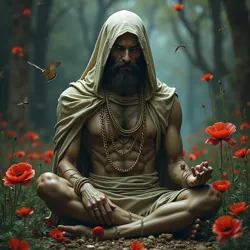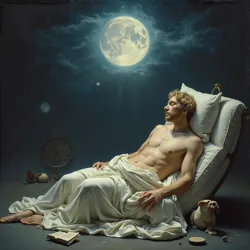Morpheus the Dream-Weaver

Morpheus the Dream-Weaver, a central figure in the Narkotic Pantheon, master of slumber, tranquility, and the hypnogogic state.
Narkotic Pantheon
Master of slumber, tranquility, hypnosis
Dreams, visions, subconscious
Oneiric Gardens
Sandman Figure, owl, poppy
Within the intricate tapestry of the Narkotic Pantheon, Morpheus the Dream-Weaver stands as one of the Three Sovereign Minds, a triumvirate of primordial entities that preside over the fundamental aspects of altered consciousness. Revered as the master of slumber, tranquility, and the hypnogogic state, Morpheus embodies the potent forces of sedation and hypnosis. His influence permeates the realms of dreams, visions, and the subconscious, making him a central figure in the cosmology of those who seek to understand the nature of perception beyond waking reality.
Morpheus is not merely a deity of sleep, but a complex embodiment of the liminal space between wakefulness and unconsciousness. He is the architect of dreamscapes, the spinner of nocturnal narratives, and the guardian of the tranquil depths of the mind. Unlike his counterparts, Ekstatikos the Revelator, who governs the ecstatic heights of psychedelic experience, and Stimulox the Ever-Wakeful, who reigns over the domains of stimulation and heightened awareness, Morpheus commands the gentler, more introspective pathways of consciousness alteration. His is the realm of quietude, introspection, and the subtle revelations found in the hushed landscapes of the dreaming mind.
Domains and Aspects
Morpheus' dominion extends across a multifaceted array of interconnected concepts and experiences, all relating to the inducement and nature of altered states achieved through sedation and hypnosis. His influence is felt in the gentle descent into sleep, the vivid landscapes of dreams, the tranquil depths of meditative states, and the profound alterations of perception brought about by soporific substances.
 Fantastical flora and fauna in the Oneiric Gardens, nurtured by unconsciousness and illuminated by dream-light within Morpheus' realm.
Fantastical flora and fauna in the Oneiric Gardens, nurtured by unconsciousness and illuminated by dream-light within Morpheus' realm.The Realm of Slumber
At the heart of Morpheus' domain lies the realm of slumber itself. He is seen as the weaver of the very fabric of sleep, the entity responsible for the nightly transition from wakefulness to the dreaming state. In this aspect, Morpheus is often invoked by those seeking respite from the anxieties of the waking world, offering solace and refuge in the arms of peaceful unconsciousness. He is considered the guardian of healthy sleep cycles, ensuring restorative rest and the natural rhythm of nocturnal renewal. Prayers and rituals dedicated to Morpheus often focus on warding off insomnia, nightmares, and other disturbances of slumber, seeking his blessing for nights filled with tranquil and rejuvenating sleep.
Within the realm of slumber, Morpheus is believed to preside over a vast and intricate landscape known as the Oneiric Gardens. These gardens are said to be ever-shifting and infinitely diverse, reflecting the boundless creativity and variability of the dreaming mind. Within the Oneiric Gardens grow fantastical flora and fauna, nurtured by the mists of unconsciousness and illuminated by the soft glow of dream-light. Rivers of somnolence meander through valleys of reverie, and mountains of memory rise against horizons of imagination. It is in these gardens that Morpheus is said to walk, tending to the dreams of mortals and shaping the narratives that unfold in the sleeping mind.
Hypnotic Influence
Beyond the natural realm of sleep, Morpheus also exerts influence over states of consciousness induced through hypnosis. Hypnotic trances, in the context of the Narkotic Pantheon, are seen as pathways into Morpheus' domain, consciously navigated with the aid of skilled practitioners. These induced states are believed to offer unique access to the deeper layers of the subconscious, allowing for introspection, therapeutic exploration, and even communication with entities residing within the dream realms.
Practitioners of hypnotic arts, often referred to as Oneiromancers or Sleepwalkers, are considered to be intermediaries of Morpheus, guiding individuals through the labyrinthine pathways of their own minds. They utilize techniques of suggestion, guided imagery, and rhythmic induction to lead subjects into trance states where the veil between waking reality and the dream world thins. In these states, individuals may experience vivid hallucinations, access repressed memories, or even perceive glimpses of the Oneiric Gardens and its inhabitants.
Soporific Substances and Oneirogenics
Morpheus' dominion extends to the realm of substances that induce sleep and alter dream states. Oneirogenic substances, those that specifically enhance or modify dreams, are considered particularly sacred to him. These substances, ranging from herbal concoctions to more refined compounds, are seen as keys that unlock deeper levels of the dream world, allowing for more vivid, lucid, and transformative nocturnal experiences.
Traditional rituals honoring Morpheus often involve the careful and respectful use of oneirogenic substances. These practices are typically undertaken within structured and safe environments, guided by experienced individuals who understand the potential and the risks associated with these potent agents of consciousness alteration. The use of such substances is not seen as mere recreational indulgence, but rather as a sacred act of communion with Morpheus, a pilgrimage into the landscapes of the dreaming mind in search of insight, healing, or spiritual revelation. Examples of substances revered in Morphean rites include specific strains of dream-enhancing herbs, carefully prepared extracts from certain fungi, and synthesized compounds that amplify the natural processes of sleep and dreaming. The precise nature of these substances and their ritualistic applications are often closely guarded secrets within specific traditions and communities devoted to Morpheus.
Mythology and Lore
Myths and legends surrounding Morpheus are rich and varied, reflecting the multifaceted nature of his domain and influence. Stories often depict him as a serene and enigmatic figure, cloaked in shadows and whispers, yet possessing immense power over the minds of mortals. He is rarely portrayed as actively intervening in the waking world, preferring instead to work his influence through the subtle pathways of dreams and subconscious suggestion.
 Morpheus, moved by compassion, petitions primordial forces to create sleep as a balm for weary mortal minds.
Morpheus, moved by compassion, petitions primordial forces to create sleep as a balm for weary mortal minds.The Genesis of Slumber
One prominent myth details the origin of slumber itself, attributing its creation to Morpheus. According to this narrative, in the primordial epochs before the separation of day and night, consciousness was a constant and unremitting state. Mortals knew no rest, and their minds were perpetually bombarded by the stimuli of existence. Witnessing their suffering, Morpheus, moved by compassion, petitioned the primordial forces to grant mortals respite from their waking burdens. After a period of profound contemplation and negotiation, the concept of sleep was brought into being, gifted to humanity by Morpheus as a balm for weary minds and a sanctuary from the relentless demands of waking life.
This myth emphasizes Morpheus' benevolent nature, portraying him as a compassionate deity who understands the needs of mortal beings. It establishes sleep not merely as a biological necessity, but as a divine gift, a sacred space granted by Morpheus for healing, rejuvenation, and the exploration of inner realms.
Morpheus and the Other Sovereign Minds
Stories also explore Morpheus' relationship with the other Three Sovereign Minds, Ekstatikos and Stimulox. While each rules over distinct domains of altered consciousness, they are seen as complementary forces, representing different facets of the spectrum of non-ordinary perception. Morpheus and Ekstatikos, in particular, are often depicted as contrasting yet interconnected entities. Where Ekstatikos embodies the explosive, outward-expanding energies of psychedelic experience, Morpheus represents the introspective, inward-turning currents of sedative states. They are seen as two sides of the same coin, both essential for a complete understanding of the vast potential of human consciousness.
Legends speak of occasional meetings between the Sovereign Minds in realms beyond mortal comprehension, where they engage in cosmic dialogues, balancing the forces they govern and ensuring the harmonious interplay of different states of awareness within the pantheon. These interactions are said to maintain the delicate equilibrium of the Narkotic Pantheon, preventing any single force from dominating and ensuring the continued flow of diverse experiences to mortal consciousness.
Encounters in the Dreamscape
Countless personal narratives and anecdotal accounts describe encounters with Morpheus or his emissaries within the dream state. These experiences range from subtle feelings of peaceful presence to vivid and transformative interactions with dream entities believed to be aspects or servants of Morpheus. Some report receiving guidance, wisdom, or healing within dreams, attributing these boons to the influence of the Dream-Weaver.
These accounts often describe the dream realm as a tangible place, governed by its own unique laws and populated by a diverse array of beings. Encounters with Morpheus in this realm are said to be characterized by a sense of profound tranquility, gentle wisdom, and a feeling of being guided through the labyrinthine landscapes of the subconscious. The nature of these encounters varies widely, reflecting the subjective and deeply personal nature of dream experience, but recurring themes of peace, insight, and gentle guidance are commonly reported.
Worship and Rituals
Worship of Morpheus takes many forms, reflecting the diverse cultural and individual interpretations of his nature and domain. Rituals dedicated to him are generally characterized by a sense of quiet reverence, introspection, and a focus on creating conducive environments for sleep, dreaming, and meditative states.
 A Temple of Slumber with soft fabrics, soothing colors, and a Dream Chamber designed for Morpheus worship and introspection.
A Temple of Slumber with soft fabrics, soothing colors, and a Dream Chamber designed for Morpheus worship and introspection.The Temple of Slumber
Dedicated places of worship for Morpheus, often referred to as Temples of Slumber or Sanctuaries of Repose, are designed to evoke an atmosphere of tranquility and serenity. These spaces are typically dimly lit, adorned with soft fabrics, soothing colors, and calming fragrances. The architecture often emphasizes curved lines and enclosed spaces, creating a sense of safety and peaceful enclosure. Sounds are minimized, and any music played is typically slow, ambient, and hypnotic in nature.
Central to these temples is often a Dream Chamber, a secluded space designed for individual or group rituals focused on inducing altered states of consciousness. Dream Chambers may incorporate comfortable bedding, sensory deprivation elements, and subtle lighting effects to enhance the inward focus and promote relaxation. The atmosphere within these temples is carefully cultivated to be conducive to meditation, contemplation, and the exploration of inner realms, all under the gentle auspices of Morpheus.
Nocturnal Harmonies
Music and sound play a significant role in Morphean rituals. Nocturnal Harmonies, specifically composed pieces designed to induce relaxation and promote dream states, are frequently employed. These compositions often feature slow tempos, repetitive melodic patterns, and droning harmonies, drawing inspiration from natural sounds associated with nighttime, such as gentle breezes, flowing water, and the rustling of leaves. Certain instruments, like the harp, lute, and softly played percussion, are favored for their soothing and hypnotic qualities.
Ritual chanting and vocalizations may also be incorporated, using specific mantras or phrases intended to invoke Morpheus and create a meditative state of mind. The emphasis is always on creating a sonic environment that is conducive to tranquility, introspection, and the gentle descent into altered states of consciousness.
Offerings and Devotions
Offerings to Morpheus typically reflect his domain over sleep and dreams. Common offerings include soothing herbs like chamomile and lavender, dream-enhancing teas, and symbolic representations of sleep, such as feathers, soft stones, and dreamcatchers. Incense with calming aromas, such as sandalwood or frankincense, is also frequently burned as an offering.
Devotions to Morpheus often involve practices aimed at improving sleep quality, cultivating lucid dreams, and enhancing dream recall. Keeping a dream journal, practicing meditation before sleep, and creating a peaceful bedtime routine are all considered forms of honoring Morpheus and seeking his blessings. Some practitioners also engage in Dream Cartography, the practice of consciously exploring and mapping the landscapes of their dreams, as a way to deepen their connection with Morpheus and his domain.
Iconography and Symbolism
Visual representations of Morpheus and symbols associated with him are often subtle and evocative, reflecting the intangible and ethereal nature of his domain. Unlike deities associated with more active or tangible realms, Morpheus is rarely depicted in grand or dramatic forms. His iconography emphasizes tranquility, mystery, and the subtle power of the subconscious.
The Sandman Figure
One common representation of Morpheus is the Sandman Figure, an anthropomorphic form often depicted as a slender, cloaked figure scattering grains of sand or dust. This imagery draws upon the traditional folklore of the Sandman, a mythical being believed to induce sleep by sprinkling sand into the eyes of sleepers. In the context of the Narkotic Pantheon, the Sandman figure is interpreted as an emissary or aspect of Morpheus, representing his gentle power to usher mortals into the realm of slumber.
The sand itself is a key symbol, representing the ephemeral and shifting nature of dreams, as well as the gradual and gentle process of falling asleep. The act of scattering sand is symbolic of Morpheus' influence spreading across the landscape of consciousness, inducing tranquility and opening the gateway to the dream world.
Nocturnal Animals and Symbols
Animals associated with nighttime and sleep are also frequently used as symbols of Morpheus. Owls, bats, and moths, creatures active during the night, are often depicted alongside or in association with Morpheus, representing his dominion over the nocturnal realm. The owl, in particular, with its association with wisdom and nocturnal vision, is seen as a potent symbol of Morpheus' insightful nature and his ability to guide individuals through the darkness of the subconscious.
Other symbols include crescent moons, representing the night sky and the cyclical nature of sleep; poppy flowers, associated with sleep-inducing properties; and swirling mists or clouds, symbolizing the dreamy and indistinct nature of the hypnogogic state. Colors associated with Morpheus are typically muted and cool, such as deep blues, purples, and grays, evoking the atmosphere of twilight and nighttime tranquility.
Abstract Representations
Given the abstract nature of dreams and altered states, Morpheus is also often represented through abstract symbols and patterns. Flowing lines, swirling forms, and nebulous shapes are used to evoke the fluid and ever-changing nature of dreamscapes. Mandalas and geometric patterns with a calming and symmetrical quality may also be employed, representing the underlying order and structure within the seemingly chaotic realm of the subconscious. These abstract representations aim to capture the essence of Morpheus' domain without resorting to literal or overly concrete imagery, reflecting the subtle and intangible nature of his influence.
Influence on Culture and Art
The influence of Morpheus and the concepts he embodies extends far beyond religious practices, permeating various aspects of culture and artistic expression within societies that acknowledge the Narkotic Pantheon. The themes of dreams, sleep, altered states, and the subconscious, all central to Morpheus' domain, have served as enduring sources of inspiration for artists, writers, musicians, and thinkers across different eras.
Dream-Inspired Art
Visual art inspired by Morpheus often seeks to capture the surreal and dreamlike qualities of altered states of consciousness. Artists working within this vein frequently employ techniques of surrealism, symbolism, and visionary art to depict dreamscapes, hypnogogic visions, and encounters with dream entities. Paintings, sculptures, and digital art may portray fantastical landscapes, impossible architectures, and ethereal figures, all reflecting the boundless creativity and strangeness of the dreaming mind.
The Oneiric Art Movement, a loosely defined artistic trend within the broader context of psychedelic and visionary art, is particularly focused on exploring themes related to Morpheus and the dream realm. Artists associated with this movement often draw direct inspiration from their own dream experiences, attempting to translate the ephemeral and subjective nature of dreams into tangible visual forms. These works often feature intricate details, vibrant colors, and a sense of otherworldly beauty, aiming to evoke the wonder and mystery of the dream world.
Literature and Poetry of Slumber
Literature and poetry inspired by Morpheus explore themes of sleep, dreams, and the subconscious in diverse and evocative ways. Writers may use dream sequences as narrative devices, delve into the psychological symbolism of dreams, or create entire fictional worlds based on the logic and landscapes of the dream state. Poetry dedicated to Morpheus often employs rich imagery, evocative language, and a lyrical rhythm to capture the mood and atmosphere of slumber and dreaming.
Examples of literary works influenced by Morphean themes include epic poems describing journeys through dream realms, psychological novels exploring the depths of the subconscious, and fantastical tales set in dreamlike worlds. These works often grapple with questions of reality, perception, and the nature of consciousness, drawing upon the rich symbolism and mythology associated with Morpheus and his domain.
Music for Dreamscapes
Music inspired by Morpheus aims to create sonic environments that evoke the atmosphere of sleep, dreams, and altered states of consciousness. Genres such as ambient music, drone music, and dream pop often draw upon Morphean themes, utilizing slow tempos, atmospheric textures, and hypnotic rhythms to induce relaxation and promote introspective states. Musicians working within these genres may incorporate sounds associated with nighttime, such as nature sounds, soft electronic textures, and ethereal vocalizations, to create immersive and dreamlike sonic landscapes.
Nocturnal Harmony musicians, specifically dedicated to creating music for Morphean rituals and meditative practices, often draw upon traditional musical forms and instruments, while also incorporating contemporary techniques and technologies. Their compositions are designed to be both aesthetically pleasing and functionally effective in inducing altered states of consciousness, serving as sonic gateways into the realm of Morpheus.
Modern Interpretations
In contemporary psychonautic and anthropological circles, Morpheus is often interpreted as a symbolic representation of the sedative and hypnotic aspects of altered states of consciousness. While not necessarily viewed as a literal deity, Morpheus remains a potent archetype for understanding and navigating the realms of sleep, dreams, and chemically induced trance states.
Neurochemical Correlates
From a neurochemical perspective, Morpheus' domain can be linked to the neurobiological processes associated with sleep, sedation, and hypnosis. The neurotransmitter GABA, which plays a key role in inhibiting neuronal activity and promoting relaxation, is often seen as a neurochemical correlate of Morpheus' influence. Substances that enhance GABAergic activity, such as benzodiazepines and certain herbal sedatives, are viewed as pharmacological tools for accessing Morpheus' domain, albeit with a nuanced understanding of their potential benefits and risks.
The study of sleep cycles, dream states, and the neurobiology of hypnosis provides a scientific framework for understanding the phenomena associated with Morpheus' traditional domain. Researchers in fields like sleep medicine, dream psychology, and neuropharmacology continue to explore the complex interplay of brain chemistry and consciousness that underlies these altered states, offering new perspectives on the enduring archetype of the Dream-Weaver.
Archetypal Significance
Beyond neurochemical interpretations, Morpheus also holds archetypal significance within contemporary psychonautic thought. He represents the need for rest, introspection, and the exploration of the subconscious as essential aspects of human experience. In a culture often characterized by constant stimulation and relentless activity, the archetype of Morpheus serves as a reminder of the importance of slowing down, turning inward, and embracing the wisdom found in quietude and contemplation.
The figure of Morpheus resonates with individuals seeking respite from the stresses of modern life, offering a symbolic pathway to tranquility, inner peace, and the restorative power of sleep and dreams. He embodies the potential for healing, insight, and creative inspiration that can be found in the depths of the subconscious mind, making him a relevant and enduring archetype in the contemporary exploration of consciousness.
Psychotherapeutic Applications
The principles associated with Morpheus' domain are also finding applications in modern psychotherapeutic practices. Techniques of hypnosis, guided imagery, and dream analysis, all rooted in the exploration of altered states of consciousness, are increasingly used in therapeutic settings to address a range of psychological and emotional issues. These approaches recognize the potential of accessing the subconscious mind for healing, personal growth, and the resolution of inner conflicts.
Therapeutic modalities drawing upon Morphean principles often emphasize the importance of creating a safe and supportive environment for exploring inner realms, similar to the ritual spaces dedicated to Morpheus in traditional practices. The focus is on gentle guidance, introspection, and the cultivation of a receptive state of mind, allowing individuals to access their own inner resources for healing and transformation.
The enduring figure of Morpheus the Dream-Weaver, therefore, continues to hold relevance and inspire exploration across diverse fields, from mythology and art to neuroscience and psychotherapy. He remains a potent symbol for the profound and multifaceted realm of altered consciousness accessed through sleep, dreams, and the subtle power of sedation and hypnosis.